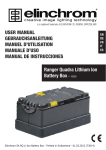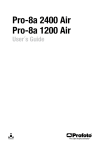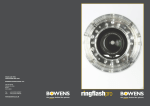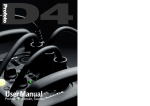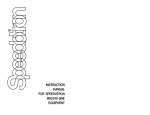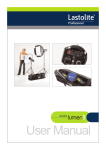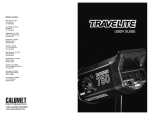Download Bowens CREO 2400 Specifications
Transcript
Owner’s Handbook contents warranty Information Warranty 2 Introduction 3 Safety Notes 3 Operation Creo Pack Overview 4 Creo Head and Remote Overview 5 Connecting & Using Flash Heads 6 Modelling Options & Synchronisation 7 Ready Indication & IR Remote Control 8 Speed Control & Test Function 9 Flash Before Ready, Fan Cooling and Protection System and Faults 10 Technical Specifications 11 All Bowens electrical products are covered by a two year warranty against any faulty design, materials and workmanship. If a product does not work on arrival or up to a maximum period of four weeks from the date of purchase, it should be returned to the dealer/retail outlet from where it was purchased, to exchange (if available) the faulty unit for a new one; if the faulty unit was part of a kit that was purchased, the dealer/ retailer may choose to simply replace the unit and not the entire kit. Alternatively the dealer may offer to repair the unit as soon as possible at no charge. If neither an exchange or repair is possible for the faulty unit, then a full refund may be made. If a warranty fault occurs after the initial four week period (and within the max two year warranty period), then the unit should be returned to the dealer, who will arrange to repair the unit as soon as possible, at no charge. This warranty does not apply to consumable items such as flash tubes, modelling lamps, fuses and consumable type batteries. Should a unit be returned at any time within the two year warranty period, and it is judged to have experienced any of the following points, failure to follow working instructions correctly, accidental or willful damage, misuse, alteration or repair by a non authorised Bowens service/repair centre, then a warranty will be deemed invalid and any repairs that may need carrying out will be payable by the owner. The cost of repairs should be notified to the owner, by the dealer, in advance of undertaking any work that may be required. No warranty repairs can be undertaken to any units without proof of purchase. All warranty repairs must be conducted with the dealer from where the product was purchased. Other terms and conditions may be applicable in specific countries, if stated by the dealer at the time of purchase. All Bowens products are certified by the CE mark. The CE certified mark is a declaration of conformity to the required EMC directives 2004/108/ EC ‘Electromagnetic Compatibility’ and 2006/95/EC ‘Low Voltage Directive’. introduction Accurate, ergonomic and robust, the Creo generator and Creo flash head have been designed by working closely with photographers to develop a system that meets the exacting high standards demanded in professional studios while remaining simple and intuitive to use. For more information about these products and to find details of your nearest Bowens dealer, please visit the Bowens website - www.bowens.co.uk In order to obtain the full benefit from your purchase, please take a few moments to familiarise yourself with this user manual. safety notes never • Switch turn power OFF before before fitting or • Always remove the power cord by gripping the • Use in an environment where moisture or removing any flash heads. plug. NEVER pull the cord. flammable vapour is likely to come into contact • Avoid placing cables where they can be tripped • Always ensure that any extension cord used has with the unit. over. Protect from heavy, sharp or hot objects, a suitable current rating to prevent overheating • Use a unit with damaged housing or mouldings. which may cause damage and replace damaged and never use a coiled extension cord. If the unit is dropped or damaged in any way cables immediately. • Have the unit serviced / repaired by an authorised Bowens service centre. always have it checked before using. 3 - Creo | introduction and safety notes always creo pack overview J A K B L C M D E O P N 4 - Creo | creo pack overview Q F G R H S I T A. 1/4” Jack Sync Connections (PG 7) B. Channel A Socket C. Channel A LED Display D. Channel A 1-Stop Power Adjust (PG 6) E. Channel A 1/10-Stop Power Adjust F. Modelling On/Off Button (PG 7) G. Ready Indication Button (PG 8) H. Modelling Mode Button (PG 7) I. Flash/Open Test Button (PG 9) J. Mains AC Power Connection K. Radio Trigger Card Slot (PG 7) L. Channel B Socket M. Channel B LED Display N. Power On/Off Button O. Channel B 1-Stop Power Adjust (PG 7) P. Channel B 1/10-Stop Power Adjust Q. Photocell / IR Receiver Window (PG 7) R. IR Remote On/Off Button (PG 6) S. Sync Options Button (PG 7) T. Recycle Speed Button (PG 9) creo head and remote control overview 1 E 2 6 A 7 4 8 F G B H C 5 9 D 1. 2. 3. 4. Channel LED Indicators Channel A +/- Power Adjust Modelling On/Off Ready Indications 5. 6. 7. 8. 9. Channel Select Channel B +/- Power Adjust Modelling Mode Sync Options Flash/Open Test A. B. C. D. Accessory Release Latch Flash Tube Modelling Lamp Glass Dome E. F. G. H. Carry Handle Locking Knob Modelling On/Off Switch Fuse Holder 5 - Creo | creo head and remote control overview 3 connecting and using flash heads One or two compatible flash heads may be connected to a Creo generator. Always switch the generator to ‘standby’ when fitting or removing any flash heads. When connecting a flash head to a Creo pack always ensure that the head connectors are fully engaged with the locking clips before turning the generator ‘on’. 6 - Creo | connecting and using flash heads When a flash head is not fully connected/fitted, the associated channel LED display will show ‘- -’. When a flash head is connected fully the appropriate channel LED display shows the selected flash power setting in f-stops. flash power control The flash power adjust buttons are used to control the power output for the associated flash head fitted to a particular channel. A single press of either 1-Stop or 1/10-Stop flash power adjust button will adjust the output by a single increment; the flash power adjustment will be confirmed by a single short beep (if the sounder is enabled). By pressing and holding a flash power adjust button, the generator will adjust the flash power at an increased rate; every increment adjustment will be confirmed by a single short beep (if the sounder is enabled). At the end of the achievable power range the generator will emit a long continuous beep until the flash power adjust button is released. The generator will not alter the actual power level setting until a short period after the user has stopped changing the setting; this is to avoid unnecessary dumping/charging of the flash power. To manually dump an excess flash power press the ‘flash/open test button’. • The STOPS +/- buttons will adjust the flash power by 1-Stop steps until the end of the achievable flash power range is reached. • The TENTHS +/- buttons will adjust the flash power by 1/10-Stop steps until the end of the achievable range is reached. The maximum flash power available from each head is dependant on the number of channels used and the flash power setting of each channel (see tables opposite for max power settings). When two heads are fitted and more power is required from a particular channel than is currently available, then the setting of the other head must be decreased i.e. when using a Creo 2400Ws, if channel A is set to 9.7 then the range of channel B is 1.0 to 6.5. By lowering the setting of channel A to 9.4 then the power range of channel B will be extended from 1.0 to 8.2. Creo 1200 Channel A Max Channel B Max 10.0 Head Not Fitted 9.7 6.5 9.4 8.2 9.0 9.0 Creo 2400 Channel A Max Channel B Max 10.0 Head Not Fitted 9.8 5.5 9.7 7.2 9.5 8.0 9.4 8.4 9.2 8.7 9.0 9.0 modelling options and synchronisation The MODEL button on the Creo control panel switches the modelling lamp on and off for any connected flash heads. The associated LED indicator will illuminate when turned ‘on’. If the modelling lamps are switched ‘on’ the user can then select a modelling mode. A single press of the MODE button will scroll through the various modelling mode options; the associated LED indicator will illuminate to highlight which mode is selected. When the modelling lamps are switched ‘off’ the various ‘modelling modes’ cannot be selected or changed and the LED indicators will remain ‘off’. Any previous modelling mode settings will be remembered and reverted to when the modelling lamps are switched back ‘on’. NB. Modelling will only work if the modelling switch on the Creo flash head is turned ‘on’. • PROP - automatically adjusts the modelling output proportionally to the flash power setting. • AUTO - automatically sets the modelling lamp on the channel with the highest power setting to max. When in AUTO mode, the modelling output on the channel with the lowest flash power setting will be set proportionally to the flash power output on the channel with the highest setting. If both channels are set to the same flash power setting then the modelling output on both channels will be set to max. • MAX - sets the modelling on both channels to max regardless of flash power settings. • FREE - when FREE mode is first selected the LED indicator will flash and the modelling intensity on each channel will be displayed on the appropriate channel LED displays. The modelling output setting for each channel can then be adjusted independently by using the STOPS and TENTHS buttons regardless of the flash power setting. Reducing the intensity below ‘1.0’ will turn the modelling lamp ‘off’ and will be indicated on the appropriate channel LED display by showing ‘- -’. The first press of a ‘+’ STOPS or TENTHS button on the associated channel will turn the lamp on at the lowest power setting. When the modelling output has been selected on each channel press the MODE button and the chosen modelling outputs on the appropriate channels will be set; the LED indicator will then stay lit continuously and the channel LED displays will revert back to showing the flash power levels. sync options The Creo generator can be sync’d with a camera in a number of ways. Each press of the SYNC button will scroll through the various available options and the appropriate LED indicator will highlight the selected option. • OFF - both LED indicators will be switched ‘off’. In this mode the Creo generator will only trigger from a camera or flash meter connected using a sync cord to either 1/4” jack sync sockets (see pack overview on page 4). • CELL - in this mode the Creo will sync via the ‘Photocell / IR Receiver window’. The Creo will trigger when either an IR signal is received or when the photocell detects a flash from another unit. • RADIO - when this option is first selected the appropriate LED indicator will flash for ten seconds. During this ten second window the Creo enters ‘learn mode’. While in ‘learn mode’ the user can sync a Pulsar transmitter with a Pulsar radio receiver card by pressing the TEST button on the Pulsar transmitter at least five times (or until Creo flashes). 7 - Creo | modelling options and synchronisation modelling mode options 8 - Creo | ready indications and ir remote control ready indications and remote control • RADIO - to use a particular channel/studio setting on the Pulsar transmitter, simply turn on the Pulsar unit and set the Pulsar to the required setting; next, select the RADIO option on the Creo generator by pressing the SYNC button, during the initial ten second period while the generator is in ‘learn mode’, press the TEST button on the Pulsar at least five times (or until the Creo flashes). The Creo will then learn the channel/studio settings of the Pulsar and set itself in accordance. • OFF - both LED indicators will be ‘off’ and no ready signal will utilised to highlight the Creo has recharged to the set power level. This setting also disables the sounder from indicating a button press. NB. The ‘Radio’ sync option will only work if a Pulsar Radio Receiver Card is inserted into the RADIO slot on top of the Creo control panel. • DIM - the modelling lamps will dim while the pack is recharging and will come back on when the Creo had recharged to the set power level. This setting also disables the sounder to indicate a button press. Because of the fast recharging capabilities of the Creo, the lamps may appear to not dim with low flash power settings. ready indications Ready indicators are used to indicate when the Creo has recharged to the set power level after being triggered. By pressing the READY button on the Creo control panel the user can select one of four different ready signals. The appropriate LED indicator(s) will show the current selection: • BEEP - the Creo will emit a clear ‘beep’ to indicate that the unit has recharged to the set power level. This setting also enables the sounder to indicate that a control button has been pressed. NB. The ‘dim’ ready indication will only be enabled if the modelling option is turned ‘on’ by using the MODEL button on the Creo control panel. • BEEP/DIM - both ‘beep’ and ‘dim’ options will be enabled to show when the Creo has recharged and to indicate that it is ready to trigger. • GREEN READY RING - the green ready indicator around the Flash/Open Test button will stay fully lit when the Creo has recharged to the set power level. While charging or dumping flash power the green indicator ring will rotate clockwise. Automatic capacitor switching is used so dumping can occur even if the flash power has been increased. remote control The Creo can be controlled remotely by using one of the Bowens Infra-Red remote controls including the Gemini IR Remote Control and the Creo IR Remote Control. All main functions can be controlled remotely except 1-Stop power adjustments and REMOTE on/off. To set the Creo to a particular radio channel press the REMOTE button on the Creo control panel when the REMOTE option is turned off, the REMOTE LED indicator will then flash to confirm the IR channel can now be altered and the Creo will display the current set IR channel on the ‘Channel B LED Display’; the IR channel can then be selected by using channel A or B +/- STOPS or TENTHS power adjust buttons. To confirm the IR channel selection press the REMOTE button once; the remote LED indicator will then stay lit continuously to confirm the selection and to indicate the REMOTE option is turned on. speed control and test function speed control • OFF - the IR receiver is ‘off’ and remote control is not possible. • FLASHING - the current IR channel setting is displayed on channel B’s LED display and can be altered using either channel A or B +/- power adjust buttons. The SPEED button on the Creo control panel makes it possible to utilise the available mains power supply by adjusting and optimising the maximum possible speed and load without blowing fuses or trip switches. The Creo’s amperage load from the mains power supply corresponds proportionally to the speed setting. • ON - the IR receiver is ‘on’ and the Creo can be controlled using one of Bowens IR remote controls. The SPEED control button is used to select one of four recycling speed settings. The appropriate LED indicator will highlight the chosen setting: Depending on the set IR channel on the Creo and the IR channel set on one of Bowens IR remote controls, the Creo will accept IR signals as follows: • 25% - the slowest recycling speed (25%) is approximately four times as long as the fastest (100%) recycling speed. This option should be selected when the Creo is connected to a mains power supply with weak fuses or inadequate sized wiring, or if you are uncertain as to how well the mains power supply is fused. It may also allow three or four generators to be connected to the same wall outlet or fuse group provided it is adequately fused. • CHANNEL 0 - ANY incoming channel from 0 (ALL) - 8. • CHANNEL 1-8 - only a matching IR channel from 1-8 or 0 (ALL). NB. If the Creo trigger option is set to CELL then using an IR remote control too close to the generator (<1m) it may cause the generator to be triggered. • 50% - this option is twice as long as the fastest 100%) recycling speed. This setting will allow two generators to be attached to the same wall outlet / fuse group (provided adequately fused). • 75% - this option is only slightly longer than the fastest (100%) recycling speed. It reduces the load by 25% and may prevent sensitive fuses from blowing. • 100% - this is the fastest recycling speed. Only one generator should be connected to any one power outlet or fuse group and this should be adequately rated and fused. DUTY CYCLE - for the longest service life it is recommended that the user always selects the slowest SPEED that is consistent with the users requirements. The Creo is designed to be able to flash up to 1000 times at 100% (full power) per hour. It is not recommended to run harder than necessary due to the effect on the life of the flash tube(s). test function 9 - Creo | speed control and test function The REMOTE LED indicator displays the current status as: The Flash/Open Test Button is used to test all light settings are correct and that the functionality is as expected. When the Flash/Open Test Button is pressed, any connected heads will flash and the ‘green ready indicator ring’ will rotate to indicate charging. flash before ready, fan cooling and protection system and faults 10 - Creo | flash before ready, fan cooling, protection system and faults flash before ready The ‘flash before ready’ feature makes it possible to trigger the Creo before recharging has been completed. If a flash is released before the generator has recharged to the set power level a ‘warbling beep’ will be emitted and the channel LED displays will flash for a short period. This is to indicate a possible under-exposed frame since the flash power may not correspond to the set power level. fan cooling and protection system The Creo is equipped with an effective cooling and protection system that operates to prevent excessive heat build-up and possible damage. The system comes into operation when working at elevated temperatures, at higher flash power settings and at faster flash rates. Limiting any of these factors will help keep the internal temperature of the Creo down. • FANS - multiple fans are automatically switched to increase the airflow through the Creo. Always keep the vents clear of obstructions and away from external sources of heat. • CHARGE LIMITER - if the Creo detects a risk of overheating by use in abnormal operating conditions, fan failure etc. then the system will protect the Creo by automatically reducing the charge rate. The appropriate SPEED LED will flash to indicate this is in operation. The Creo can still be used in this mode but it is recommended that the reason for the increased temperature is found and removed. • OVERHEAT - if the charge limiter fails to prevent the temperature rising then the recharging will stop completely. This will be indicated by ‘OH’ on both ‘channel LED displays’. The generator cannot be used in this state; once the temperature has decreased sufficiently then recharging will continue automatically. The automatic protection should normally only operate under extreme or fault conditions or when the air vents are blocked. If an overheat condition occurs it is recommended the Creo is left switched ‘on’ without triggering it to allow the fans to reduce the temperature accordingly. fault indications If a fault develops the Creo will show an error code; this will override the ‘channel LED display’. Error codes will be displayed as follows: Channel A Display Channel B Display Meaning E1 01 Inter-board communication failure E1 02 Incorrect capacitor block configuration E2 01 Low mains input E2 02 Low DC link voltage E2 03 Low mains input and low DC links voltage E2 08 Discharge fault 01-63 Thermal sensor fault number indicates fault sensor E3 If an error code is displayed it does not necessarily mean that the unit is faulty but rather a particular parameter is out of limits. The error may correct itself once the cause has been removed or if the Creo is switched to ‘standby’ and back ‘on’. If a fault persists then the generator should be sent to a Bowens authorised service centre for analysis. technical specifications Creo 1200 Creo 2400 Rated Energy (F10) 1200Ws Rated Energy (F10) 2400Ws Input Power Supply 100-127V / 200-240V 50/60Hz Input Power Supply 100-127V / 200-240V 50/60Hz Automatic Multi-Voltage Yes (use appropriately rated modelling lamp) Automatic Multi-Voltage Yes (use appropriately rated modelling lamp) Fuse Slow Blow Fuse 16A @ 230V / 20A @ 117V Fuse Slow Blow Fuse 16A @ 230V / 20A @ 117V Auto Fuse / Breaker Per Generator Type C,D,E 16A / 230V, 20A / 117V Auto Fuse / Breaker Per Generator Type C,D,E 16A / 230V, 20A / 117V Digital Energy Display Yes (in digital F-Stops) Digital Energy Display Yes (in digital F-Stops) Max Number of Heads 2 Max Number of Heads 2 Total Energy Control Range F2.0 - F10.0 Total Energy Control Range F1.0 - F10.0 Energy Control Increments 1-Stop and 1/10-Stop Adjustments Energy Control Increments 1-Stop and 1/10-Stop Adjustments Energy Distribution Channel A=F2.0-F10.0 / Channel B=F2.0-F9.0 Energy Distribution Channel A=F1.0-F10.0 / Channel B=F1.0-F9.0 Auto Power Dumping Yes Auto Power Dumping Yes Manual Power Dumping Yes Manual Power Dumping Yes Speed Control 100%, 75%, 50% and 25% Speed Control 100%, 75%, 50% and 25% Ready Indications Beep, Lamp Dimming and Beep+Lamp Dimming Ready Indications Beep, Lamp Dimming and Beep+Lamp Dimming Max Rated Modelling Lamp 300W @ 120V / 650W @ 230V Max Rated Modelling Lamp 300W @ 120V / 650W @ 230V Sync Sockets 2 x 1/4” phono jack sockets Sync Sockets Photocell Sync Yes - Flash/IR Slave with noise filter Photocell Sync Yes - Flash/IR Slave with noise filter Radio Sync Yes - compatible with Pulsar Radio Module Radio Sync Yes - compatible with Pulsar Radio Module Cooling Managed Multiple Fans Cooling Managed Multiple Fans Size 36 x 29.7 x 20.5cm / 14.2 x 11.7 x 8.1” Size 44.2 x 29.7 x 20.5cm / 17.4 x 11.7 x 8.1” 12Kg / 26.5lbs Weight CREO 1200 PERFORMANCE 15.35Kg / 33.85lbs CREO 2400 PERFORMANCE Guide Number (@3m / 100ISO ) 128.7 (with Keylite Reflector) Guide Number (@3m / 100ISO ) Recycle Time (to full power / 100%) 0.56 seconds Recycle Time (to full power / 100%) 0.9 seconds Repetition Rate at 100% Speed & Power Level 2.0 - 8 Flashes / 4.0 - 6 Flashes / 6.0 - 4 Flashes Repetition Rate at 100% Speed & Power Level 1.0 - 8 Flashes / 3.0 - 6 Flashes / 5.0 - 4 Flashes Repetition Rate at 100% Speed & Power Level 8.0 - 3 Flashes / 10.0 - 1.7 Flashes Repetition Rate at 100% Speed & Power Level 7.0 - 3 Flashes / 10.0 - 1 Flash Flash Duration @ t=0.5 1/5000 sec (min power) - 1/2400 sec (max power) Flash Duration @ t=0.5 1/5000 sec (min power) - 1/1500 sec (max power) Fastest Camera Shutter Speed 1200Ws 1/500 with cable, IR. 1/250 with Pulsar Fastest Camera Shutter Speed 2400Ws 1/500 with cable, IR. 1/250 with Pulsar Energy Stability Flash to Flash ± 1/50 F-Stop Energy Stability Flash to Flash Colour Stability Flash to Flash ± 40K Colour Stability Flash to Flash ± 40K Colour Stability Energy Range 10.0 - 7.0 = ±65K Colour Stability Energy Range 10.0 - 7.0 = ±50K Colour Stability Energy Range 10.0 - 4.0 = ±80K Colour Stability Energy Range 10.0 - 3.0 = ±80K Colour Stability Energy Range 10.0 - 2.0 = ±175K Colour Stability Energy Range 10.0 - 1.0 = ±180K 186.5 (with Keylite Reflector) ± 1/50 F-Stop 11 - Creo | technical specifications Weight 2 x 1/4” phono jack sockets PART CODES CREO 1200 BW-9005 CREO 2400 BW-9000 CREO FLASH HEAD BW-7760 FLASH TUBE (CLEAR) BW-3019 MODELLING LAMP (230V) 650W - BW2503 300W - BW2504 MODELLING LAMP (117V) 300W - BW7515 GLASS DOME (UV COATED) BW-2981 GLASS DOME (CLEAR) BW-2982 GLASS DOME (FROSTED) BW-2983 CREO REMOTE CONTROL BW-7770 www.bowens.co.uk BWL0670-2 | Creo User Guide 11/2012













